
NGC 4725 is an intermediate barred spiral galaxy with a prominent ring structure, located in the northern constellation of Coma Berenices near the north galactic pole. It was discovered by German-born astronomer William Herschel on April 6, 1785. The galaxy lies at a distance of approximately 40 megalight-years from the Milky Way.

NGC 4639 is a barred spiral galaxy located in the equatorial constellation of Virgo. It was discovered by German-born astronomer William Herschel on April 12, 1784. John L. E. Dreyer described it as "pretty bright, small, extended, mottled but not resolved, 12th magnitude star 1 arcmin to southeast". This is a relatively nearby galaxy, lying approximately 72 million light-years away from the Milky Way. It is a companion to NGC 4654, and the two appear to have interacted roughly 500 million years ago. NGC 4639 is a member of the Virgo Cluster.
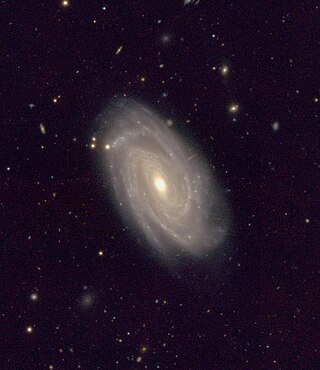
NGC 10 is a spiral galaxy located in the southern constellation of Sculptor. It was discovered by John Herschel on 25 September 1834. The galaxy is located at a distance of 346 Mly from the Sun. Its morphological classification in the De Vaucouleurs system is SAB(rs)bc, where the 'SAB' denotes a weak-barred spiral, '(rs)' indicates a slight ring-like structure, and 'bc' means the spiral arms are moderately to loosely wound. Paturel et al. (2003) assigned this galaxy a classification of SBbc, indicating a barred spiral galaxy.
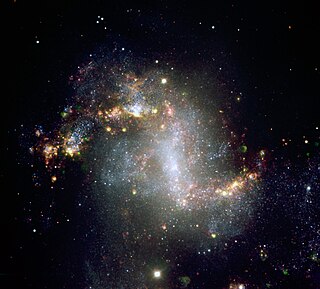
NGC 1313 is a field galaxy and a barred spiral galaxy discovered by the Scottish astronomer James Dunlop on 27 September 1826. It has a diameter of about 50,000 light-years, or about half the size of the Milky Way.
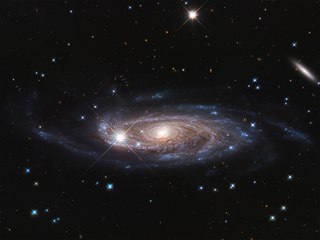
UGC 2885 is a large barred spiral galaxy of type SA(rs)c in the constellation Perseus. It is 232 million light-years (71 Mpc) from Earth and measures 463,000 ly (142,000 pc) across, making it one of the largest known spiral galaxies. It is also a possible member of the Pisces-Perseus supercluster.

NGC 151 is a mid-sized barred spiral galaxy located in the constellation Cetus.

NGC 6104 is a barred spiral galaxy located in the constellation Corona Borealis. It is designated as S(R)Pec in the galaxy morphological classification scheme, though it is clearly a barred spiral, and was discovered by William Herschel on 16 May 1787. The galaxy is approximately 388 million light-years away.

NGC 6181 is a barred spiral galaxy located in the constellation Hercules. It is designated as SB(rs)c in the galaxy morphological classification scheme and was discovered by William Herschel on 28 April 1788. The galaxy is 107 million light years away.

NGC 6221 is a barred spiral galaxy located in the constellation Ara. In de Vaucouleurs' galaxy morphological classification scheme, it is classified as SB(s)bc and was discovered by British astronomer John Herschel on 3 May 1835. NGC 6221 is located at about 69 million light years from Earth.

NGC 6373 is a barred spiral galaxy located in the constellation Draco. It is designated as SBc in the galaxy morphological classification scheme and was discovered by the American astronomer Lewis A. Swift on 13 June 1885. There are two recorded supernovae in this galaxy designated SN 2001ad and SN 2012an.

NGC 266 is a massive barred spiral galaxy in the constellation Pisces. NGC 266 is located at a distance of 197 megalight-years from the Milky Way. It was discovered on September 12, 1784, by William Herschel. The form of this barred galaxy is described by its morphological classification of SB(rs)ab, which indicates a quasi-ring-like structure (rs) and moderate-to-tightly wound spiral arms (ab). It is the dominant member of a small group with six low-mass galaxies.
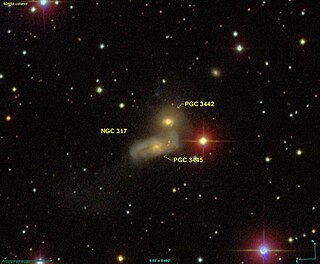
NGC 317 is a pair of interacting galaxies, consisting of a lenticular galaxy NGC 317A and a spiral galaxy NGC 317B, in the constellation Andromeda. It was discovered on October 1, 1885 by Lewis Swift.

UGC 12158 or PGC 69533 is an Sb-type barred spiral galaxy located approximately 384,000,000 ly (118 Mpc) away from Earth in the constellation of Pegasus. Its tight spiral disk spans approximately 140,000 ly (40 kpc), whose scale at heliocentric distance is about 36.9 kiloparsecs per arcminute. It is also often stated to resemble the Milky Way in appearance, with a similar central bar and spiral arm structure.

NGC 4424 is a spiral galaxy located in the equatorial constellation of Virgo. It was discovered February 27, 1865 by German astronomer Heinrich Louis d'Arrest. This galaxy is located at a distance of 13.5 million light years and is receding with a heliocentric radial velocity of 442 km/s. It has a morphological class of SB(s)a, which normally indicates a spiral galaxy with a barred structure (SB), no inner ring feature (s), and tightly-wound spiral arms (a). The galactic plane is inclined at an angle of 62° to the line of sight from the Earth. It is a likely member of the Virgo Cluster of galaxies.

NGC 3191 is a barred spiral galaxy in the constellation Ursa Major. It is located at a distance of about 400 million light years from Earth, which, given its apparent dimensions, means that NGC 3191 is about 115,000 light years across. The galaxy has been distorted and interacts with a companion 1.3 arcminutes to the west. An extremely blue tidal bridge lies between them.
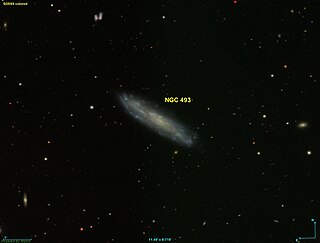
NGC 493, also occasionally referred to as PGC 4979 or GC 281, is a barred spiral galaxy in the constellation Cetus. It is located approximately 90 million light-years from Earth and was discovered on December 20, 1786 by astronomer William Herschel. It was later also observed by his son, John Herschel. John Dreyer, creator of the New General Catalogue, described the galaxy as "very faint, large, much extended 60°" with "a little brighter middle".

NGC 495, also occasionally referred to as PGC 5037, UGC 920 or GC 278, is a barred spiral galaxy in the constellation Pisces. It is located approximately 184 million light-years from the Solar System and was discovered on 12 September 1784 by astronomer William Herschel.

NGC 521, also occasionally referred to as PGC 5190 or UGC 962, is a barred spiral galaxy located approximately 224 million light-years from the Solar System in the constellation Cetus. It was discovered on 8 October 1785 by astronomer William Herschel.

NGC 606 is a barred spiral galaxy located in the Pisces constellation about 470 million light-years from the Milky Way. It was discovered by the French astronomer Édouard Stephan in 1881.

NGC 1325 is a flocculent spiral galaxy situated in the constellation of Eridanus. Located about 75 million light years away, it is a member of the Eridanus cluster of galaxies, a cluster of about 200 galaxies. It was discovered by William Herschel on 19 December 1799.




















